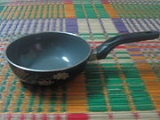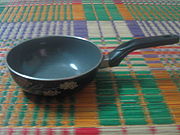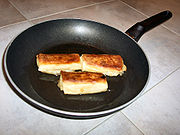
Non-stick pan
Encyclopedia

Development
The first non-stick pans were made using a coating of Teflon (polytetraflouroethylene or PTFE). PTFE was invented serendipitously by Dr. Roy Plunkett in 1938, while working for a joint venture of the DuPontDuPont
E. I. du Pont de Nemours and Company , commonly referred to as DuPont, is an American chemical company that was founded in July 1802 as a gunpowder mill by Eleuthère Irénée du Pont. DuPont was the world's third largest chemical company based on market capitalization and ninth based on revenue in 2009...
company. The substance was found to have several unique properties, including very good corrosion resistance and the lowest coefficient of friction of any substance yet manufactured. PTFE was used first to make seals resistant to the uranium hexafluoride
Uranium hexafluoride
Uranium hexafluoride , referred to as "hex" in the nuclear industry, is a compound used in the uranium enrichment process that produces fuel for nuclear reactors and nuclear weapons. It forms solid grey crystals at standard temperature and pressure , is highly toxic, reacts violently with water...
gas used in the Manhattan Project
Manhattan Project
The Manhattan Project was a research and development program, led by the United States with participation from the United Kingdom and Canada, that produced the first atomic bomb during World War II. From 1942 to 1946, the project was under the direction of Major General Leslie Groves of the US Army...
during World War II
World War II
World War II, or the Second World War , was a global conflict lasting from 1939 to 1945, involving most of the world's nations—including all of the great powers—eventually forming two opposing military alliances: the Allies and the Axis...
and was regarded as a military secret. Dupont registered the Teflon trademark in 1944 and soon began planning for post-war commercial use of the new product.
By 1951, Dupont had developed applications for Teflon in commercial bread and cookie-making, however the company avoided the market for consumer cookware due to potential problems associated with release of toxic gases if stovetop pans were overheated in inadequately ventilated spaces. Marc Grégoire, a French engineer, had begun coating his fishing gear with Teflon to prevent tangles. His wife Colette suggested using the same method to coat her cooking pans. The idea was successful and a French patent was granted for the process in 1954. The Tefal
Tefal
Tefal is a French cookware and small appliance manufacturer owned by Groupe SEB. Its name is a portmanteau of the words TEFlon and ALuminium.Tefal is known for creating the non-stick cookware category....
company was formed in 1956 to manufacture non-stick pans.
Modern non-stick pans do not necessarily use Teflon. Other non-stick coatings for pans have since been invented. For example, a mixture of titanium
Titanium
Titanium is a chemical element with the symbol Ti and atomic number 22. It has a low density and is a strong, lustrous, corrosion-resistant transition metal with a silver color....
and ceramic
Ceramic
A ceramic is an inorganic, nonmetallic solid prepared by the action of heat and subsequent cooling. Ceramic materials may have a crystalline or partly crystalline structure, or may be amorphous...
can be sandblasted onto the pan surface, and then fired to 2000 °C (3,632 °F).
Uses and limitations

Cooking oil
Cooking oil is purified fat of plant origin, which is usually liquid at room temperature ....
to allow the food to be moved about the cooking pan. The cleanup process is also made much easier for foods which leave a residue on the pan.
PTFE-coated frying pans usually require the use of a non-metallic (usually plastic) spatula to avoid scratching of the coated surface.
Tony Polombo observes that non-stick pans are not a universal panacea. He notes that, in particular, ordinary stainless steel pans are better for producing pan gravy, because the fond (the caramelized drippings that stick to the pan when meat is cooked) sticks to them, and can be turned into pan gravy by deglazing
Deglazing (cooking)
Deglazing is a cooking technique for removing and dissolving caramelized bits of food from a pan to make a pan sauce.When a piece of meat is roasted, pan fried or prepared in a pan with another form of dry heat, a deposit of caramelized sugars, carbohydrates, and/or proteins forms on the bottom of...
them — dissolving them in liquid. Non-stick pans, according to Polombo, produce inferior pan gravies.
Health concerns
Concerns have been raised over the possible negative effects of using PTFE-coated cooking pans. When pans are overheated beyond approximately 349 °C (660.2 °F) the PTFE coating begins to dissociate, releasing byproducts which can cause polymer fume feverPolymer fume fever
Polymer fume fever or fluoropolymer fever, also informally called Teflon flu, is an inhalation fever caused by the fumes released when Polytetrafluoroethylene is heated to between 300 °C and 450 °C. When PTFE is heated above 450 °C the pyrolysis products are different and inhalation may cause...
in humans and can be lethal to birds. Compounds in non-stick cookware may be associated with elevated cholesterol levels in children and teens.

